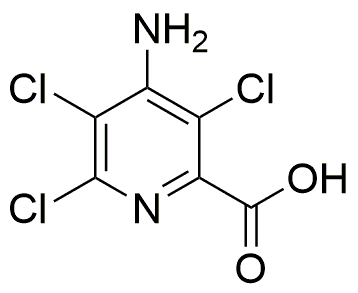Picloram is widely utilized in research focused on:
- Agricultural Herbicide: Commonly used in agriculture to control broadleaf weeds and woody plants, making it essential for maintaining crop health and yield.
- Forestry Management: Applied in forest management practices to manage invasive species and promote the growth of desirable trees, helping to sustain forest ecosystems.
- Environmental Research: Used in studies examining the impact of herbicides on ecosystems, aiding researchers in understanding chemical interactions in soil and water.
- Weed Control in Non-Crop Areas: Effective for controlling unwanted vegetation in non-crop areas such as roadsides and railways, enhancing safety and visibility.
- Research on Plant Physiology: Serves as a tool in plant biology studies to investigate plant responses to herbicides, contributing to the development of more sustainable agricultural practices.
General Information
Properties
Safety and Regulations
Applications
Picloram is widely utilized in research focused on:
- Agricultural Herbicide: Commonly used in agriculture to control broadleaf weeds and woody plants, making it essential for maintaining crop health and yield.
- Forestry Management: Applied in forest management practices to manage invasive species and promote the growth of desirable trees, helping to sustain forest ecosystems.
- Environmental Research: Used in studies examining the impact of herbicides on ecosystems, aiding researchers in understanding chemical interactions in soil and water.
- Weed Control in Non-Crop Areas: Effective for controlling unwanted vegetation in non-crop areas such as roadsides and railways, enhancing safety and visibility.
- Research on Plant Physiology: Serves as a tool in plant biology studies to investigate plant responses to herbicides, contributing to the development of more sustainable agricultural practices.
Documents
Safety Data Sheets (SDS)
The SDS provides comprehensive safety information on handling, storage, and disposal of the product.
Product Specification (PS)
The PS provides a comprehensive breakdown of the product’s properties, including chemical composition, physical state, purity, and storage requirements. It also details acceptable quality ranges and the product's intended applications.
Certificates of Analysis (COA)
Search for Certificates of Analysis (COA) by entering the products Lot Number. Lot and Batch Numbers can be found on a product’s label following the words ‘Lot’ or ‘Batch’.
*Catalog Number
*Lot Number
Certificates Of Origin (COO)
This COO confirms the country where the product was manufactured, and also details the materials and components used in it and whether it is derived from natural, synthetic, or other specific sources. This certificate may be required for customs, trade, and regulatory compliance.
*Catalog Number
*Lot Number
Safety Data Sheets (SDS)
The SDS provides comprehensive safety information on handling, storage, and disposal of the product.
DownloadProduct Specification (PS)
The PS provides a comprehensive breakdown of the product’s properties, including chemical composition, physical state, purity, and storage requirements. It also details acceptable quality ranges and the product's intended applications.
DownloadCertificates of Analysis (COA)
Search for Certificates of Analysis (COA) by entering the products Lot Number. Lot and Batch Numbers can be found on a product’s label following the words ‘Lot’ or ‘Batch’.
*Catalog Number
*Lot Number
Certificates Of Origin (COO)
This COO confirms the country where the product was manufactured, and also details the materials and components used in it and whether it is derived from natural, synthetic, or other specific sources. This certificate may be required for customs, trade, and regulatory compliance.


